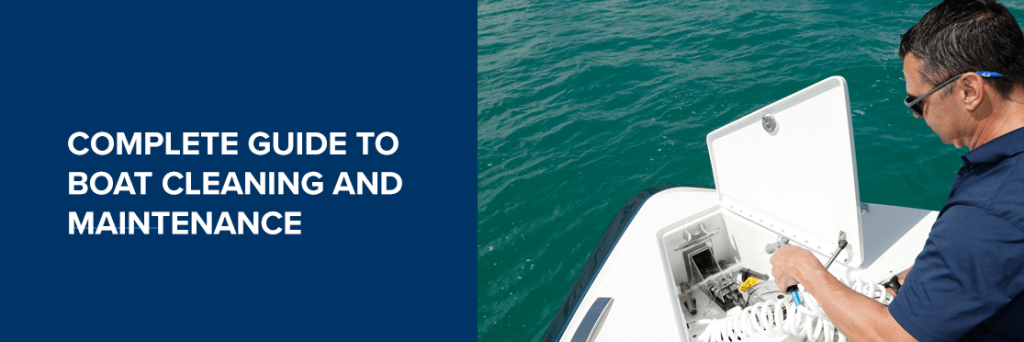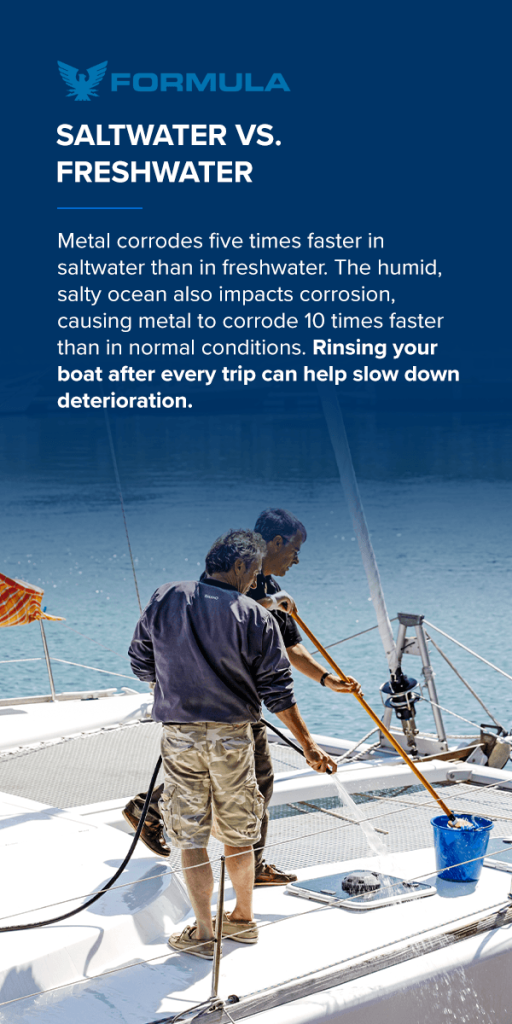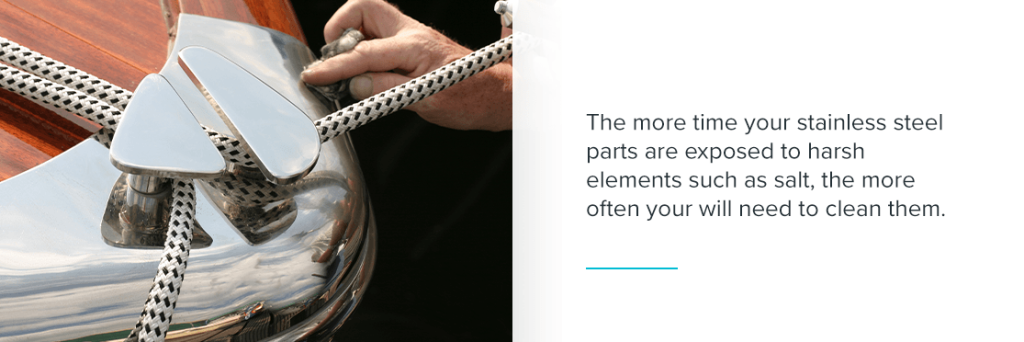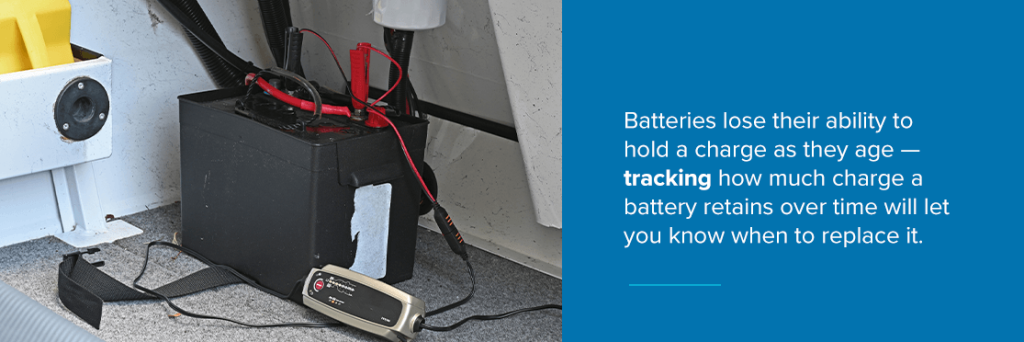
Buying a boat is a significant, long-term investment, and not just in terms of money. It takes considerable time and energy to maintain your boat and keep it clean. This process can be tricky and lengthy, but you must prioritize boat maintenance to ensure your boat runs smoothly for years to come and you get the most out of your investment.
This guide is a comprehensive look into boat cleaning and maintenance, so you can clean and maintain your boat properly every time.
Tips on Boat Cleaning
Understanding how to clean your boat is crucial. Neglecting to do so can effectively ruin your boat’s interior and exterior components and cost you more money to repair it in the long run. This process will depend on three factors — what type of boat it is, what material it is made of and how you use it. These different factors will also affect how often you should clean your boat.
Boat Type
What kind of boat do you own? Read about some popular boat types and how to clean them properly:
1. Sailboats
Many sailboats have a large, prominent deck you must clean weekly. The deck material will influence how you clean it. An excellent place to start is to use mild soap that is less likely to strip any wax on the deck. Depending on the wear, buff, polish and wax the deck every two to three months.
Wash the sail and other fabric components every three or four months, using a soft brush and mild detergent to clean the sail. Ensure the sail is completely dry before reattaching it to prevent mildew buildup. For stubborn mildew, use a small amount of bleach with detergent.
2. Pontoon Boats
Start by rinsing your boat, then apply the appropriate cleanser. Once your pontoon is dry, buff and polish it. Use the proper metal protectant to prevent oxidation and algae buildup.
3. Deck Boats and Bowriders
These boats are often considered family boats and can have seating in the bow. The bow seating needs regular cleaning, depending on how often you use it. Always wipe down seats with a soft cloth and water after a day out to prevent dirt buildup. Gently wash the deck and bow after every use. Extensive cleaning should occur when the dirt is noticeable or every few months.
4. Catamarans
Catamarans have two hulls that are connected. These boats usually have larger interior cabins between the two hulls. There are two main types of catamarans — power and sailing.
Sailing catamarans follow a similar cleaning routine to sailboats as they have a sail that will require regular cleaning. You will also have to clean the interior every time you use it and do a deep clean every couple of months. This is the same for power catamarans, except they do not have a sail.
Every few months, you should lift the boat out of the water to properly clean the part of the hull that sits in the water.
5. Houseboats
Whether you live in a houseboat year-round, for a few months or for a few days, they require more intensive cleaning. Wash heavily used areas daily or weekly. Do a full deep clean every few months. If you have added nonslip surfaces, you must treat them with the appropriate products after heavy use. Wood houseboats will require oil and varnish reapplication to keep them watertight.
6. Cabin Cruisers
With living spaces on board, cabin cruisers need additional cleaning. How long you spend on the cruiser will influence how often you clean different areas. Living areas get cleaned daily or weekly. Clean the hull, deck and storage areas every few months, similar to sailboats.
7. Center Consoles
Center consoles are simple boats that usually have a steering column, a canopy and space to sit. Daily cleaning includes washing the exterior with soap and fresh water, wiping down surfaces and flushing the motor or generator. You should wax the hull, stainless steel components and powder-coat parts every few months.
How and Where You Use Your Boat
Depending on where you use your boat, you will need to use different cleaning measures, as various environments and activities can impact your routine:

1. Saltwater vs. Freshwater
Metal corrodes five times faster in saltwater than in freshwater. The humid, salty ocean also impacts corrosion, causing metal to corrode 10 times faster than in normal conditions. Rinsing your boat after every trip can help slow down deterioration. Regularly check any metal components for corrosion and replace them as necessary.
Saltwater boat hulls accumulate barnacles and algae, requiring frequent cleaning to keep them clear of debris. Waxing your hull can also prevent salt from embedding in the hull. Freshwater boats can develop blisters in their hulls as they absorb water over time. Check your hull for any large blisters and coat it before blisters multiply or become larger.
2. Water Sports
Treat any nonskid paint or mats with the appropriate products. Wash the deck, seating and other components after every use. Ensure essential parts such as the tow bar are secure and clear of any obstructions. Properly dry your boat at the end of the day.
3. Fishing
If you have a livewell system or cooler on your fishing boat, try to clean it weekly. Use baking soda and water to flush out the system and scrub it thoroughly. Rinse it several times after washing it — bleach and other harsh detergents might leave a residue that might transfer to bait and fish.
Make sure you clean up any spills on the deck and upholstery as soon as possible. Protect your upholstery by wiping them down after every use and applying a vinyl protectant or other fabric sealants to prevent stains from sticking.
4. Family Cruising
Spot clean any tough stains on the seating with the relevant cleaner. Rinse your boat after every use, including wiping down windows. Scrub your deck every time you go out and wash and wax your hull every few months. Avoid using wax on any nonskid surfaces. Vacuum any cabins, carpets and other fabrics after every trip.
Boat Material
Of course, the material your boat is made of inside and out will make a difference in how you clean it:
1. Stainless Steel
Avoid using abrasive detergents and supplies when cleaning stainless steel. Find cleaners specifically for stainless steel for the best results and clean your stainless steel parts after every use. If these parts are not easily accessible, make this part of your deep clean every few months. The more time your stainless steel parts are exposed to harsh elements such as salt, the more often your will need to clean them. Use anti-corrosion paints where possible.

2. Fiberglass and Finer Reinforced Plastic
Apply wax every few months to protect the fiberglass from oxidation. Polishing the gelcoat will give your boat a shiny look and feel. Wipe down and clean any surfaces with warm water and fiberglass-specific soap. You can carefully use a pressure washer to clean your hull and deck every month or so to remove any dirt buildup.
3. Wood
The best way to take care of a wooden boat is to keep it as clean as possible. Any debris can create issues in the long run. Wash any wooden parts with warm water and soap after every use. The type of wood on your boat will depend on how you wax and polish it. Always refer to the manual for care instructions, but waxing after every few washes is a good idea. Oil wood surfaces to protect them from the elements.
4. Molded Polyethylene
Boats and parts made out of molded polyethylene require less maintenance than other materials. Wash it down with soap and warm water after every trip. Deep clean the boat every few months or when it becomes noticeably dirty.
5. Aluminum
Clean your aluminum boat at least once a month. Wipe down the surfaces with a cloth and aluminum-specific soap. Dishwashing soap is a good alternative if you are out of cleaning supplies. You can also use a broom and dustpan to remove dirt.
Rinse everything thoroughly and let the boat dry in indirect sunlight, using a towel for smaller parts. Use aluminum wax on your boat twice a year to protect it from sun exposure. Polish the metal before the wax dries completely.
Boat Maintenance Tips
You must perform the proper maintenance to ensure your boat remains in optimal condition. The more you use your boat, the more regular your maintenance will be. There are four stages to boat maintenance:
Before and After Every Trip
Before and after every trip out on the water, do the following:
- Engine: Before you launch, check your oil pressure and oil operating temperatures. Look for any cowl air intake blockages and remove them. Make sure you have enough oil in your engine and assess the state of your oil filter.
- Propeller: Thoroughly inspect your boat’s propeller to see if there is any damage to the blades or the propeller housing. Even a small dent can make your engine less fuel-efficient, as it will have to work harder to compensate. Ensure your propeller is tightly fastened to its housing or your boat.
- Battery: Check the battery charge levels. Batteries lose their ability to hold a charge as they age — tracking how much charge a battery retains over time will let you know when to replace it. Remember to look at the connecting cables, as well. Cabling and connections degrade faster in saltwater environments.
- Bilge pump: Inspect the different parts of your bilge pump, such as the hoses, inlet screens and float switches. Check for any blockages, debris or damage that can hamper the bilge pumping water. If you have an electric bilge pump, switch it to automatic for the duration of your trip.
- Fuel tank: Check your fuel line, filter and primer bulb for any damage or obstructions. If you suspect your fuel might be contaminated at any time, empty your tank and fill it with clean fuel. Clean up any dirt on or around your fuel tank if possible.
- Hull: Inspect your hull for any damage, such as scratches, dents or cracks. Ensure your drain plugs are in good shape and secure. Look for barnacles or any other buildup on the hull.
- Trailer: Taking care of your trailer is just as important as taking care of your boat. Inspect the safety chains, winch, winch strap and tie-downs for any damage. Make sure they are all in working condition and appropriately secured. Check that the electrical systems, including lights and connectors, are working correctly. Inflate your tires properly.

During Mid-Season
As you get close to the halfway point of your typical boating season, you should conduct more thorough checks, including:
- Engine: Inspect the engine components for leaks and damage. Replace the filters and sparkplugs. Keep an eye out for algae, mold or mildew in and around the engine — you can clean and use preventative sprays if necessary. Check the hose and hose clamps for rust, especially if you spend a lot of time in saltwater.
- Battery: Regular maintenance can significantly extend the life of boat batteries. Check the terminals and cable ends for any damage or loose collections. Clean them and add grease. Replace your battery if it is charging slowly or not retaining a charge. Look at the electrolyte levels and top up the water as needed.
- Seats: Fabric materials are quick to degrade out on the water. Check for any worn-out or broken materials and replace them. Ensure seat fastenings are tight and free of corrosion. Apply a waterproof spray to fabric or areas where needed.
- Electronics: Test all your electronics and electric systems, even if you use them infrequently. Examine all the cables for damage. Make sure all connections are tight and clean.
- Hull: A clean hull will move more easily through the water, so clean your hull of any barnacles, algae scum and scale buildup. Check the props for damage, replace any degraded zincs and clear any debris from through-hulls.
- Trailer: Inspect the suspension for rust, damage and missing bolts. Deal with any rust and repaint your trailer to prevent further corrosion. Examine your tire treads — even your spare — and check the grease levels of your wheel bearings and seals.
Before Storing Your Boat
When it is time to bring the boating season to an end, conduct the following maintenance steps to successfully store your boat:
- Cabin: Clean out the cabin, removing any items you have forgotten. Search for any mildew, dampness, leaks and pests. Inspect the cleats, rails and deck fittings for any corrosion or looseness. Check that all the cabin and internal electronics, lights and electrical systems work.
- Engine: Inspect your engine’s wiring, hosing and connections for damage, including rust and mildew. Winterize your boat’s engine — top up the coolant, flush the engine with clean water and replace the oil. Swap out all the filters for new ones and fill up the antifreeze reservoir of your inboard engine. Remember to store your outboard motor vertically. Prevent corrosion by spraying fogging oil on spark plug connections and the carburetors. Also, test for any loose connections, hoses, mounts and housing.
- Fuel: Inspect your fuel lines for any damage and replace them as needed. Siphon out any fuel left over in the tank before storage to prevent condensation. Alternatively, top up your tank until it is nearly full, add a fuel stabilizer and run your engine for around 10 minutes to get the stabilizer through the system. Replace any fuel filters.
- Batteries: Remove your batteries. Check the terminals, connections and wires for corrosion, damage and wear and tear. Clean the cable ends and terminals before coating them in grease. Store your battery in a specialized maintainer or use a smart charger over winter to keep it charged correctly.
- Trailer: Deep clean your trailer before putting it into storage. Apply grease to any points where corrosion might be a concern. Check the pressure of your tires and wheel bearings — repack, replace and refill if necessary. Prevent flat spots from forming on your tires by lifting them off the floor with wooden blocks. Keep an eye out for any corrosion and test your lights.
Taking Your Boat out of Storage
When boating season rolls back around and you prepare to enjoy some time on the water, do the following as you take your boat out of storage:
- Lights: Ensure all lights are working on your boat, replacing any dim or broken bulbs. Even if you only plan on taking day trips, it is best to prepare for any eventuality, including being able to navigate safely in the dark.
- Trailer: Thoroughly inspect your boat trailer for fasteners, straps, springs and rollers or bunks that are worn or corroded. Replace worn tires, grease or repack bearings and check the brake fluid levels. Finally, make sure the coupler is working correctly.
- Storage: Check your boat’s storage spaces for any dampness and damage.
- Engine: Add new, clean fuel to your fuel tank. Check your battery — it will either need to be charged or replaced, depending on its condition. Run your engine as soon as possible and listen to how it runs. If it is running rougher than usual, you should take a closer look for any damage. Inspect your engine oil, coolant, spark plugs and power steering fluid, then replace and top up as needed.
- Electronics: If you disconnected any electronics when putting your boat into storage, now is the time to reconnect and test them.
- Other: Inspect every part of your boat for mold, mildew or corrosion. Even on the cleanest boats, these issues can worsen when in storage. Assess wires, connections and other components for any damage. Repair or replace the parts as needed. Check the waterproofing and reapply where needed.
Explore the Boating Selection From Formula Boats
The dedicated team at Formula Boats has over 60 years of experience in providing our customers with memorable boating experiences. If you are in the market for a new boat, you can rest assured that we have the expertise to guide you through choosing the right boat for your needs. Request a catalog from our team or contact us today!

